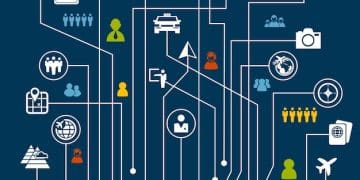The Industrial Revolution’s 2025 Impact on US Labor Laws

The Impact of the Industrial Revolution on US Labor Laws and Working Conditions in 2025 involves analyzing how historical industrial advancements inform future labor legislation, workplace environments, and employee well-being amidst evolving technological landscapes and economic structures.
The Impact of the Industrial Revolution on US Labor Laws and Working Conditions in 2025 demands a deep dive into past transformations to predict future challenges and opportunities. As technology advances at an unprecedented rate, understanding historical parallels becomes crucial for shaping equitable and effective labor policies.
Understanding the Roots: Industrial Revolution and Early Labor Laws
The Industrial Revolution, beginning in the late 18th century, fundamentally reshaped societies and economies worldwide. In the United States, this period led to significant changes in work environments, prompting the need for labor laws.
Early industrialization brought about factories, mass production, and an influx of workers from rural areas to urban centers. These developments exposed workers to harsh conditions and long hours.
The Rise of Labor Movements
As industrialization progressed, workers realized that collective action was necessary to address their grievances. This realization led to the rise of labor movements and unions.
- Knights of Labor: One of the earliest significant labor organizations, advocating for broad social and economic reforms.
- American Federation of Labor (AFL): Focused on practical goals like better wages, shorter hours, and improved working conditions for skilled workers.
- Industrial Workers of the World (IWW): Advocated for radical changes to the capitalist system, aiming to unite all workers regardless of skill or trade.

The efforts of these movements eventually led to the passage of landmark legislation aimed at protecting workers’ rights. These early laws set the stage for modern labor regulations.
In conclusion, the Industrial Revolution and the labor movements it spawned were pivotal in shaping the initial labor laws in the U.S., establishing a foundation for future worker protections.
Key Labor Laws Shaped by Industrialization
Several key labor laws emerged as direct responses to the challenges posed by industrialization. These laws aimed to mitigate the adverse effects of rapid industrial growth on the workforce.
These laws aimed to mitigate the adverse effects of rapid industrial growth on the workforce, focusing on safety regulations, child labor restrictions, and fair wages.
Landmark Legislation
Several pieces of legislation stand out as foundational in protecting workers’ rights during and after the Industrial Revolution.
- Sherman Antitrust Act (1890): Initially intended to curb business monopolies, it was sometimes used against labor unions, highlighting the complex relationship between government and labor.
- Clayton Antitrust Act (1914): Amended the Sherman Act to explicitly exempt labor unions from its provisions, recognizing their right to organize and collectively bargain.
- Fair Labor Standards Act (FLSA) (1938): Established minimum wage, overtime pay, and child labor standards across the nation, providing a baseline for worker protections.
These laws laid the groundwork for a more equitable relationship between employers and employees, addressing some of the most pressing issues of the time.
The passage and enforcement of these laws were essential steps in improving working conditions and ensuring fairer treatment for American workers.
Technological Advancements and Shifting Work Environments
Technological advancements have always been at the heart of industrial revolutions, driving new forms of production and altering work environments. Understanding these shifts is critical for predicting future trends.
The introduction of new technologies, from steam engines to automated machinery, has consistently redefined the nature of work, requiring workers to adapt to new skills and roles.
The Evolution of Work
Throughout history, technological progress has led to both increased productivity and significant disruptions in the labor market.
- Automation: The increasing use of machines to perform tasks previously done by humans, leading to both job displacement and the creation of new, more specialized roles.
- Globalization: The integration of economies worldwide, resulting in increased competition and the relocation of manufacturing jobs to countries with lower labor costs.
- Digitalization: The shift towards digital technologies and data-driven processes, requiring workers to develop skills in areas like data analysis, software development, and cybersecurity.
These trends have created both challenges and opportunities for workers, requiring ongoing investment in education and training to stay competitive in the job market.
The evolving work environment necessitates a proactive approach to labor law, ensuring that workers are protected and have the resources they need to succeed in a rapidly changing economy.
Anticipating the Future: Labor Laws in 2025
Looking ahead to 2025, it is essential to anticipate how the Industrial Revolution’s legacy will continue to shape labor laws and working conditions in the United States.
Considering current trends and emerging technologies, it is likely that labor laws will need to adapt to address new challenges and opportunities in the workforce.

Key Areas of Focus
Several areas are likely to be central to labor law debates in the coming years.
- Gig Economy: Addressing the needs and protections of independent contractors and freelance workers in the rapidly growing gig economy.
- Automation and AI: Managing the impact of automation and artificial intelligence on job displacement and the need for worker retraining programs.
- Remote Work: Establishing clear guidelines for remote work arrangements, including issues like wage and hour laws, safety regulations, and data security.
As these issues become more prevalent, policymakers will need to develop innovative solutions that balance the interests of employers and employees.
By learning from the past and anticipating future trends, it is possible to create a labor law framework that supports a thriving and equitable economy in 2025 and beyond.
The Gig Economy and Worker Classification
The rise of the gig economy presents unique challenges for labor law. Traditional employment structures are being replaced by short-term contracts and freelance work, blurring the lines between employees and independent contractors.
Understanding the implications of different worker classifications is crucial for ensuring fair treatment and access to benefits for all workers.
Employee vs. Independent Contractor
The distinction between employees and independent contractors has significant implications for worker rights and employer responsibilities.
Employees are typically entitled to minimum wage, overtime pay, unemployment insurance, and workers’ compensation. Independent contractors, on the other hand, are responsible for their own taxes, benefits, and insurance.
As the gig economy continues to grow, policymakers must address the challenges of worker classification and ensure that all workers have access to adequate protections.
The gig economy and evolving worker classifications necessitate ongoing monitoring and updates to labor laws to ensure fair practices and economic stability.
Adapting Labor Laws for a Digital Age
The digital age has brought about transformative changes in the way we work, communicate, and conduct business. Labor laws must adapt to reflect these changes and address the unique challenges they present.
Focusing on remote work policies, data privacy, and cybersecurity in the workplace is crucial for protecting workers’ rights in the digital era.
Remote Work and Cybersecurity
Remote work has become increasingly common, offering flexibility and convenience for both employers and employees. However, it also raises several legal and ethical considerations.
Ensuring data privacy and cybersecurity in remote work environments is essential for protecting sensitive information and preventing data breaches. Clear policies and procedures must be in place to govern remote work arrangements and safeguard employee data.
Adapting labor laws to address the challenges of the digital age is critical for fostering a safe, secure, and productive work environment for all.
Understanding and addressing the legal implications of remote work, data privacy, and cybersecurity is crucial for protecting both employees and employers in the digital age.
| Key Point | Brief Description |
|---|---|
| ⚙️ Industrial Revolution | Shaped the need for labor laws due to harsh working conditions. |
| ⚖️ Key Labor Laws | FLSA and others protect workers’ rights and ensure fair treatment. |
| 💻 Digital Age Challenges | Remote work, data privacy, and cybersecurity are key concerns. |
| 🌐 Gig Economy | New regulations are needed to protect freelance workers. |
Frequently Asked Questions
▼
The Industrial Revolution led to urbanization, factory work, and the need for labor laws to protect workers from harsh conditions and exploitation in factories.
▼
The Fair Labor Standards Act (FLSA), Sherman Antitrust Act, and Clayton Antitrust Act all arose in response to the problems caused by industrialization.
▼
Technological advances have led to automation, globalization, digitalization, requiring a workforce capable and adaptable to change.
▼
Specific challenges in 2025 include the gig economy, the effect of automation and AI, and new remote work guidelines and concerns.
▼
An employee receives protections such as minimum wage and overtime, while independent contractors handle their taxes, benefits, and have no safety nets.
Conclusion
The Impact of the Industrial Revolution on US Labor Laws and Working Conditions in 2025 will largely depend on heeding the lessons from industrial eras past, most notably in responding to the challenges posed by new technologies and the evolution of work structures. The future of labor law should focus on adaptability and inclusivity to ensure equitable working environments for all.





